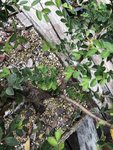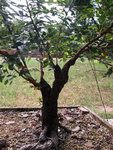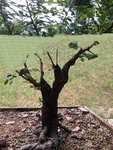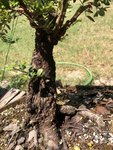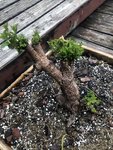I had recommended flat cuts when doing the initial chop, because you never know where it is going to back bud, and the buds would determine the design.
I intended to tell you to go back and trim, carve, re-cut the stubs, once the "keeper branches" had been chosen. It is important you wait until the "keeper branches" have developed enough that bumping them while carving the stubs won't knock them off the tree.
THis tree is only 3 or 4 months from the initial "Chops". It has made remarkable recovery. As a northerner, I am amazed at how much growth you have gotten this year. So I was planning on telling you about carving, re-shaping the stubs. I just didn't think we'd need to get to it so quickly.
The "reverse taper" should not be an issue, as I see this tree needed several cycles of growing out, then pruning back hard, then growing out, then pruning back hard. NO FURTHER TRUNK CHOPS NEEDED.
Carve the flat stubs to diagonal concave wounds that
@Bonsai Nut described, both on the left side as illustrated but also on the right side, too. You want to let your keeper branches extend until they are at least half the diameter of the trunk they emerge from. Then cut them back. For as fast as this tree is growing in your climate, I'm sure sometime next year you will be pruning these keepers. But for now, let them lengthen.
At least this is my advice.
I would have walked you through how to ground layer and develop a new, radial nebari, but you seem to really like the roots you have, so I will hold off on that until you decide you want to change the surface roots.
The strength of this tree is the nice bark it has. I would keep as much of the old trunk as possible.


